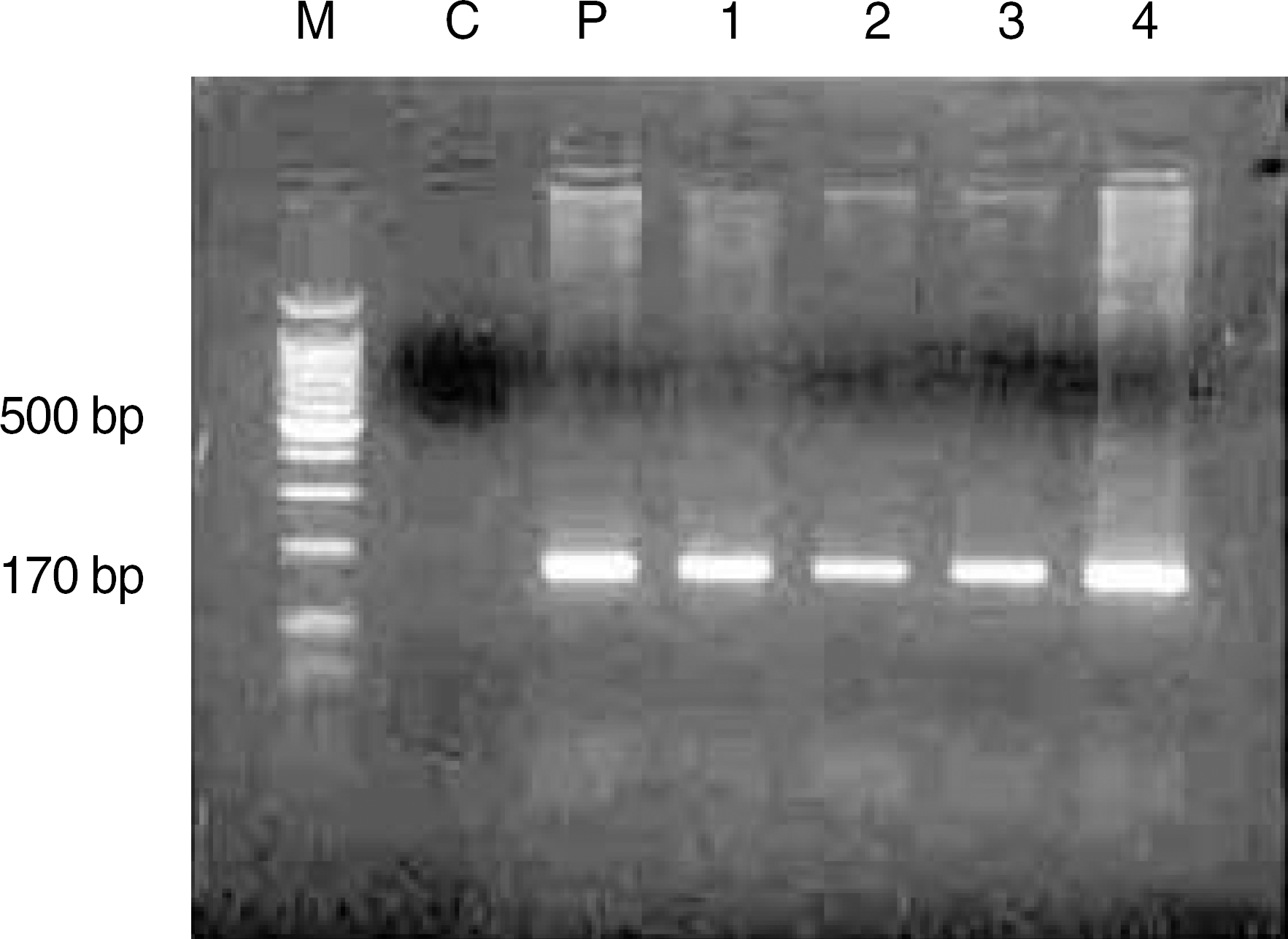Abstract
Background
It is known that the Y chromosome or Y-specific sequence is present in about 6% of Turner syndrome (TS) patients and that it predisposes them to gonadoblastoma formation with an estimated risk of 15–25%. In this study, we performed a polymerase chain reaction (PCR) in 32 patients with TS to detect Y-specific sequence. The results were compared with those obtained by the fluorescence in situ hybridaization (FISH) method.
Methods
Cytogenetic analysis was performed by phytohaemagglutinin (PHA)-stimulated peripheral lymphocyte cultures, using G-banding. DNA was extracted from peripheral blood for PCR. Seven different sets of oligonucleotide primers, sex determining region Y (SRY), zinc finger gene on the Y chromosome (ZFY), testis specific protein Y (TSPY), DYZ3, DYF49S1, RNA binding motif protein (RBM), and DYZ1, spanning on centromeres and short and long arms of the Y chromosome were used for PCR. FISH was carried out using X and Y chromosome enumeration probe for Xp11.1-q11.1 (DXZ1 locus) and Yp11.1-q11.1 (DYZ3 locus), respectively.
Results
Among 32 patients with TS, four (12.5%) were positive for Y specific sequence by PCR. Of these, two patients were detected previously by a cytogenetic analysis: 45,X/47,XYY and 45,X/46,XY. Only one Y specific sequence, DYZ3, was detected by PCR in the other two patients without cytogenetically obvious Y chromosome. Y signal was not detected by FISH for the last two patients.
Conclusions
It may be reasonable to consider using a PCR method to screen for Y-specific sequences in all patients with TS. Even though we did not demonstrate Y-signal by FISH in patients with PCR positive and cytogenetically no obvious Y chromosome, FISH may be another useful method in TS patient, and futher investigation is nessessary.
Go to : 
References
1. Ford CE, Jones KW, Polani PE, De Almeida JC, Briggs JH. A sex-chromosome anomaly in a case of gonadal dysgenesis (Turner's syndrome.). Lancet. 1959; 1:711–3.

2. Fernandez-Garcia R, Garcia-Doval S, Costoya S, Pasaro E. Analysis of sex chromosome aneuploidy in41 patients withTurner syndrome: a study of ‘hidden’ mosaicism. Clin Genet. 2000; 58:201–8.
3. Jacobs P, Dalton P, James R, Mosse K, Power M, Robinson D, et al. Turner syndrome: a cytogenetic and molecularstudy. Ann Hum Genet. 1997; 61:471–83.
4. Verp MS, Simpson JL. Abnormal sexual differentiation and neoplasia. Cancer Genet Cytogenet. 1987; 25:191–218.

5. Jang YW, Chun HJ, Kim EJ, Jeon DS, Kim JR, Lee YJ, et al. PCR-based analysis for Y-specific sequence in patients with Turner syndrome. Korean J Clin Pathol. 1998; 18:271–8.
6. Yorifuji T, Muroi J, Mamada M, Uematsu A, Kawai M, Momoi T, et al. Analysis of the SRY gene in Turner syndrome patients with Y chromosomal material. J Med Genet. 2001; 38:E41.

7. Mendes JR, Strufaldi MW, Delcelo R, Moises RC, Vieira JG, Kasamatsu TS, et al. Y-chromosome identification by PCR and gonadal histopathology in Turner's syndrome without overt Y-mosaicism. Clin Endocrinol (Oxf). 1999; 50:19–26.

8. Patsalis PC, Sismani C, Hadjimarcou MI, Kitsiou-Tzeli S, Tzezou A, Hadjiathanasiou CG, et al. Detection and incidence of cryptic Y chromosome sequences in Turner syndrome patients. Clin Genet. 1998; 53:249–57.

9. Mitelman F, editor. An International System for Human Cytogenetic Nomenclature. Basel: Karger;1995.
10. Troche V, Hernandez E. Neoplasia arising in dysgenetic gonads. Obstet Gynecol Surv. 1986; 41:74–9.

11. Medlej R, Lobaccaro JM, Berta P, Belon C, Leheup B, Toublanc JE, et al. Screening for Y-derived sex determining gene SRY in 40 patients with Turner syndrome. J Clin Endocrinol Metab. 1992; 75:1289–92.

12. Coto E, Toral JF, Menendez MJ, Hernando I, Plasencia A, Benavides A, et al. PCR-based study of the presence of Y-chromosome sequences in patients with Ullrich-Turner syndrome. Am J Med Genet. 1995; 57:393–6.

13. Binder G, Koch A, Wajs E, Ranke MB. Nested polymerase chain reaction study of 53 cases with Turner's syndrome: is cytogenetically undetected Y mosaicism common? J Clin Endocrinol Metab. 1995; 80:3532–6.

14. Quilter CR, Taylor K, Conway GS, Nathwani N, Delhanty JD. Cytogenetic and molecular investigations of Y chromosome sequences and their role in Turner syndrome. Ann Hum Genet. 1998; 62:99–106.

15. Page DC. Y chromosome sequences in Turner's syndrome and risk of gonadoblastomaor virilisation. Lancet. 1994; 343:240.
16. Tsuchiya K, Reijo R, Page DC, Disteche CM. Gonadoblastoma: molecular definition of the susceptibility region on the Y chromosome. Am J Hum Genet. 1995; 57:1400–7.
17. Yorifuji T, Muroi J, Kawai M, Sasaki H, Momoi T, Furusho K. PCR-based detection of mosaicism in Turner syndrome patients. Hum Genet. 1997; 99:62–5.

18. Alvarez-Nava F, Soto M, Martinez MC, Prieto M, Alvarez Z. FISH and PCR analyses in three patients with 45,X/46,X,idic(Y) karyotype: clinical and pathologic spectrum. Ann Genet. 2003; 46:443–8.
Go to : 
 | Fig. 1.Multiplex PCR amplification of the DYZ3 gene (M, marker; C, negative control; P, positive control; lanes 1–4, Cases 1–4 was described in Table 3).
Abbreviation: PCR, polymerase chain reaction.
|
Table 1.
Primers and product for PCR amplication
Table 2.
Various karyotypes of 32 patients with Turner syndrome
Table 3.
Summary of positive results of PCR and FISH analyses for presence of Y-chromosome material




 PDF
PDF ePub
ePub Citation
Citation Print
Print


 XML Download
XML Download